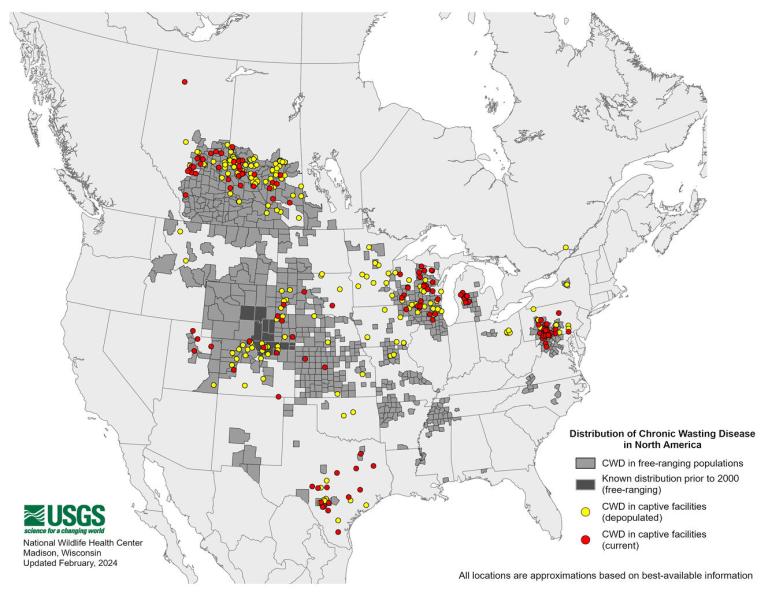February 2024 Edition | Volume 78, Issue 2
Published since 1946
Looking Backwards to Know Where to Go: Leveraging Historical Data to Guide Chronic Wasting Disease Management
The USGS Wisconsin Wildlife Research Unit and the USGS Montana Cooperative Wildlife Research Unit carried out a comprehensive survey of nine states (Illinois, Indiana, Iowa, Kentucky, Michigan, Minnesota, Missouri, Ohio, and Wisconsin) to evaluate the effect of differing harvest regulations on realized harvest, the actual number of deer harvested by hunters, with a particular focus on regulatory changes employed after local chronic wasting disease detections in the Midwest.

Management and conservation of deer species are one of the most significant duties of wildlife management agencies in North America. The importance of proper management of deer populations arises from the fact that deer hunting and associated license sales form the financial basis for funding most conservation activities for game and non-game species alike in many states.
Deer are managed for a variety of objectives including, recreational hunting opportunities, conservation purposes, wildlife viewing, as well as minimization of their impact on ecosystem health and the safety and economic interests of the local citizens. To meet ongoing and competing deer management goals and to address emerging threats such as chronic wasting disease (CWD), managers need to understand the efficacy of different management actions. For example, recreational harvest is the primary tool that managers use to manipulate deer population sizes and densities; however, there is currently a lack of a comprehensive evaluation on the efficacy of various harvest regulations that are aimed at manipulating the number of deer harvested within a given management unit.
To tackle this problem, researchers first had to understand the full breadth and nature of harvest regulations that are and have been employed by individual state agencies. Researchers identified each state’s harvest management structure (bag or quota), past, current, and future/potential changes made to harvest limits, season lengths and the spatial extent of harvest units themselves (Brandell et. al 2022; https://www.frontiersin.org/articles/10.3389/fevo.2022.943411/full). Based on the survey, researchers provided analysis regarding how managers can move toward a standardized data collection paradigm surrounding harvest management to improve regional research and cooperation.
Guided by the findings of the survey, researchers are currently working with state wildlife agency partners to create an analytical framework that would allow for within and between-state comparisons of the efficacy of various harvest regulations. To date, researchers have collected harvest records and regulations from six states spanning the years 2001- 2022 and are in the process of collecting records from two more.
Concurrently, researchers are developing a Bayesian model that evaluates how changing harvest limits and season lengths affects realized harvest within each of the states’ deer management units, while also assessing the effects of these regulations across the Midwest region. This allows researchers to balance a regional perspective with the inherent differences between each state’s management and the hunting heritage and how that may implicitly affect how hunters therein respond to regulatory changes. The project is also evaluating how differing levels of hunter participation, specific incentivized harvest structures (e.g., earn a buck), regulations aimed at controlling CWD, and the time since a regulatory change affect realized harvest.
Lastly, researchers have developed an approach to disentangle and examine hunter demand and success to understand the drivers of these processes. By modeling both hunter demand and success, rather than success solely as has been traditionally done, researchers can provide managers with a unique assessment of how realized harvest is affected by not only factors that influence success such as weather or crop phenology, but also hunter demand and its associated drivers. This is critical information when creating harvest regulations aimed at manipulating deer populations to achieve specified objectives. Researchers are employing an approach to investigate hunter demand and success within Wisconsin where individual hunter level data is available to support the analyses.
Management of deer in the Midwest will continue to be a critical activity for many state wildlife agencies. Given the challenges and complexities in manipulating harvest to achieve population and disease objectives, the findings of the study and associated methodological developments are poised to provide a foundation for understanding the efficacy of various regulatory structures and inform managers’ decision-making.
The ONB features articles from U.S. Geological Survey, Cooperative Fish and Wildlife Research Units. The Units are leading exciting, new fish and wildlife research projects that we believe our readers will appreciate reading about.